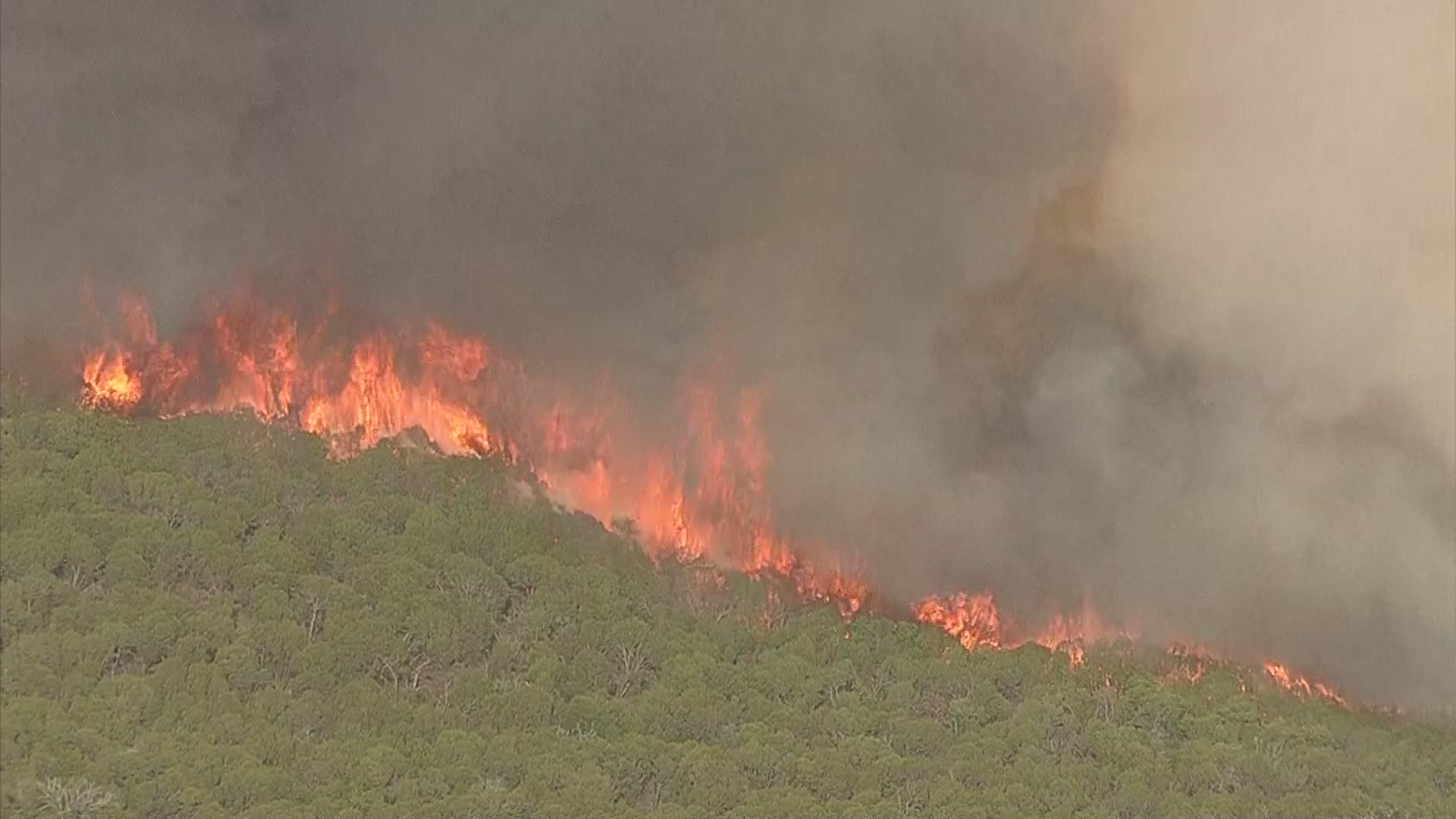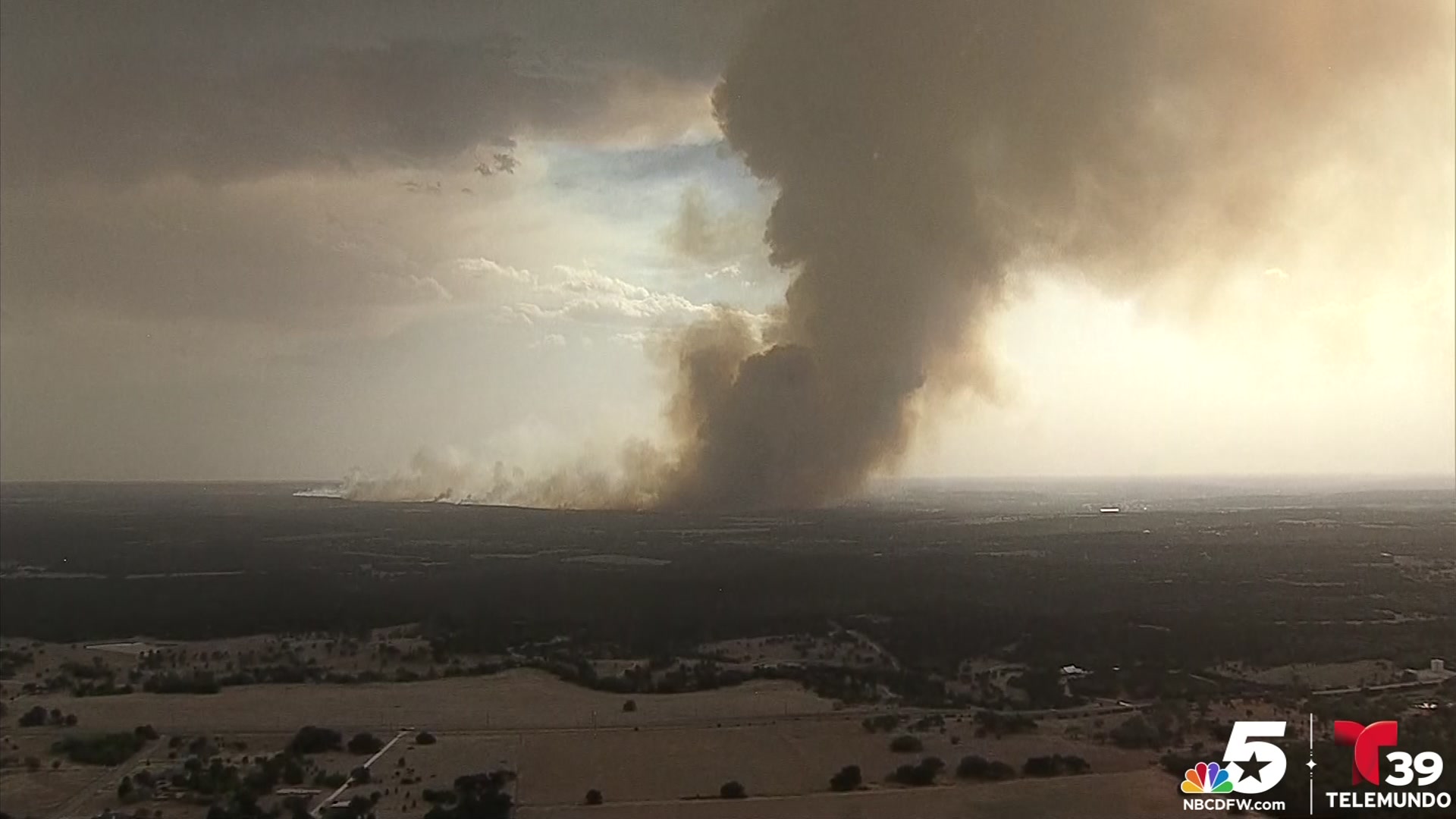What to Know
- As of Wednesday afternoon, the Chalk Mountain Fire has burned more than 6,300 acres and was about 10% contained. No injuries have been reported.
- The fire has destroyed 16 homes and damaged five others. That count does not include non-residences, outbuildings, or other structures.
- A Red Flag Fire Warning is in effect -- drought conditions have left much of North Texas ripe for fire.
The Chalk Mountain Fire, which has been burning in Somervell County since Monday, has now destroyed 16 homes and damaged five others while scorching more than 6,300 acres of land, according to the Texas A&M Forest Service.
Five homes were also destroyed in the 1148 Fire at Possum Kingdom Lake, bringing the total number of homes destroyed by wildfires in North Texas this week to 21.
The Chalk Mountain Fire is burning in an area between Dinosaur Valley State Park and Chalk Mountain, about 45 miles southwest of Fort Worth and about 4 and a half miles southwest of Glen Rose.
Get top local stories in DFW delivered to you every morning. Sign up for NBC DFW's News Headlines newsletter.
The forest service said Wednesday afternoon the fire is still only 10% contained and that the majority of the active fire is on the northeast side where firefighters were using dozers and aircraft to try to slow the progression of the fire.
Erath County Emergency Management Spokeswoman Cyndi Smith, helping Somervell County on this fire, said a fire disaster designation from Gov. Greg Abbott Tuesday night opened the way for additional resources from the federal government, including firefighters from other states.
"That will give the county assistance in the resources that have been spent, the money that’s been spent on having personnel actively working this fire," Smith said.
Firefighters from Colorado immediately went to the Somervell County front lines Wednesday to help relieve Texas firefighters, Smith said.
Also joining the fight Wednesday afternoon were two new resources, the Very Large Air Tanker out of Austin, a modified DC-10 that can dump thousands of gallons of water or retardant, and Large Air Tankers out of Abilene. Together, the VLAT and LATs dropped about 60,000 gallons of fire retardant on the northern and eastern edges of the fire on Wednesday.
Texas A&M Forest Service said hundreds of firefighters, including many volunteer departments, were already in the area working the fire. Bulldozers continued to work to establish containment lines while engines from various agencies work to fight the fire.
Evacuee Cody Bowling and his wife Melissa Slayton took with them 40 animals from their ranch where they raise thoroughbred race horses. They stopped to check on the animals Wednesday at the Somervell Expo Center evacuation shelter where livestock was also welcome.
"One of the main reasons we moved early is because of the smoke. The smoke keeps moving southeast and we’re southeast of the fire. From what they told us we’re in the direct path of it," Bowling said. "Horses can not take the smoke so easily so we got them out of there as fast as we could. If we’d waited until the last minute, we couldn’t have gotten them all out."
The couple is staying in a trailer they brought to the expo center, hoping that their ranch will be spared.
The Texas A&M Fire Service has been using helicopters to check on the fire.
“We knew that we were going to see smoke and there was concern with heat. And that's why we ordered additional dozers, and also we have aircraft over the fire,” Texas A&M Fire Service spokesperson Mary Leathers said.
Texas A&M Forest Service spokesperson Adam Turner told the Associated Press on Tuesday that no injuries have been reported and the cause of the Chalk Mountain Fire was under investigation, but it isn't believed to have been intentionally set.
Turner has said drought conditions in the region have left the area ripe for fire.

SOMERVELL COUNTY FIRE
RESIDENTS ASKED TO VOLUNTARILY EVACUATE
As of midnight Tuesday morning, residents north of U.S. Highway 67 and west of Highway 52 were asked to voluntarily evacuate, according to Cyndi Smith with the Erath County Office of Emergency Management who is serving as public information officer. All residents are asked to check in with the emergency operations center by calling 254-897-2242.
At the Expo Center evacuation shelter in Glen Rose, Suzanne Brown received hugs from friends and loved ones Tuesday. As she escaped from the fire, she took cellphone video of her home burning to the ground after avoiding a similar bush fire years ago.
“And we saw where the flames were and we were kind of concerned. We thought, 'no problem.' And about 10 minutes later they were coming down the road going, 'you've got to go now.' And we were one of the last ones out and drove through the flames on both sides of the road to get out," Brown said.
Nearby, Mike Lohman’s family also evacuated but their home was untouched.
“It was pretty scary. We just loaded up and left. But, luckily the wind did change direction. Not for the people in that direction, I guess,” Lohman said.
The Somervell County Sheriff's Office said there is poor visibility in the area and that people should also avoid traveling to the area to see the fire. "Please be aware of emergency vehicles in the area and please stay off the roads and out of the way as they fight this fire," the department said.
EVACUATIONS ORDERS LIFTED IN HOOD COUNTY
Hood County officials lifted mandatory evacuation orders given earlier Tuesday.
Late Tuesday afternoon, Hood County Judge Ron Massingill ordered the mandatory evacuation of a rural area south of Tolar, about 45 miles southwest of Fort Worth, where the Chalk Mountain Fire appeared to be advancing.
A reception center was set up at the Methodist Church on Loop 567. If assistance is needed call 682-936-4788.
A tweet on Hood County's official Twitter page Tuesday night announced that the evacuation orders were lifted.
RECEPTION CENTER ESTABLISHED FOR EVACUEES
Somervell County set up a reception center at the Somervell County Expo Center for any and all evacuees who need shelter, and help for animals and livestock was being provided by the Texas Animal Health Commission. If anyone needs trailers to help move livestock they can call the EOC.
Officials with the forest service said residents should expect to see smoke in the air as the firefight continues.
Donations of food and water for evacuees, first responders and pets will be accepted at the Expo Center, and cash donations and gift cards are being accepted at the Somervell County Sheriff's Office.
“Everyone is showing up with donations and support and offering to help in any way they can. That's what Glen Rose does,” volunteer Marilyn Phillips said.
Suzanne Brown said support from the Red Cross and from friends and neighbors was comforting after she lost everything, but survived.
“I'm getting everything together so they can help us with cots and anything else we might need,” Brown said.
INTENSE HEAT TAKING A TOLL ON FIREFIGHTERS
The intense heat is making firefighting efforts difficult, and several firefighters have been treated on the scene for heat-related illnesses, but none have been hospitalized.
"The bad news is, the weather that we have today, we're going to see for the next several days, so that makes containing the fire a little difficult, but we're going to keep at it and each day we're going to get a little more containment on it," said Texas A&M Forest Service spokesperson Mary Leathers.
Leathers said that anything flammable is on fire and there is a lot of dry vegetation and very dry juniper trees fueling the fire. Homes have been lost in the fire, but an accurate count was not available Tuesday morning.
COMANCHE PEAK NUCLEAR PLANT NOT IN DANGER
As for Comanche Peak Nuclear Power Plant, Texas A&M Forest Service spokesman Mary Leathers said there is no threat.
"The nuclear power plant is in front of the fire but it's in really good condition. We've got a nice wide road between the fire and the plant, and the plant has got a lot of asphalt and concrete so the threat is not to the plant. The threat is to the homes that lie between the fire and Highway 56."
The Texas A&M Forest Service said there have been 38 fires across the state on Monday burning more than 2,600 acres.
TEXAS WILDFIRE MAPS
2011 TEXAS WILDFIRES
In April 2011, during an extreme drought, four out-of-control wildfires burning in close proximity to each other were dubbed The Possum Kingdom Complex Fire. The fires scorched 126,000 acres of parched Texas ranch land and destroyed 168 homes and two churches.
Senior Meteorologist David Finfrock said in the NBC 5 docu-series Inside the Storm: Texas Burning, that at that time the period from August 2010 to July 2011 was the driest 12 consecutive months on record.
Later that summer, in August, a second fire erupted near the lake called the PK 101 Ranch fire. That fire burned more than 6,000 additional acres on the south side of the lake and destroyed nearly 40 more homes.
On Sept. 4, 2011, a massive wildfire erupted in Central Texas. The Bastrop County Complex Fire, east of Austin, became the most destructive wildfire in Texas history. More than 1,600 homes and structures were destroyed when 32,000 acres were scorched, including 96% of the 6,565-acre Bastrop State Park. Two people died in the fires.
During that 2011 fire season, the Texas A&M Forest Service said more than 31,000 fires burned more than four million acres across the state and destroyed 2,947 homes.
CONTINUING WEATHER COVERAGE
Stay up to date with the latest weather forecast from NBC 5's team of Weather Experts by clicking here or by watching the video below.

Be prepared for your day and week ahead. Sign up for our weather newsletter.
NBC 5's Ken Kalthoff contributed to this report.



